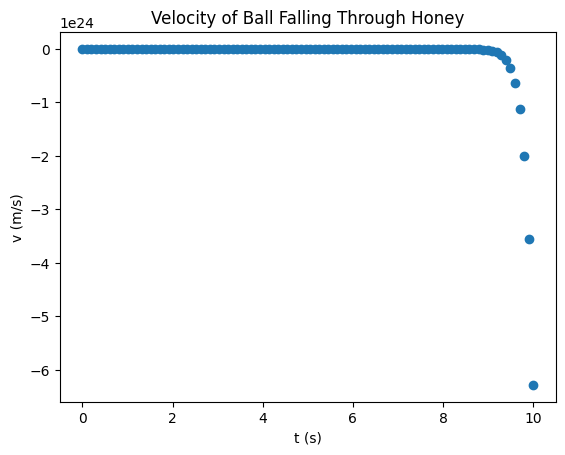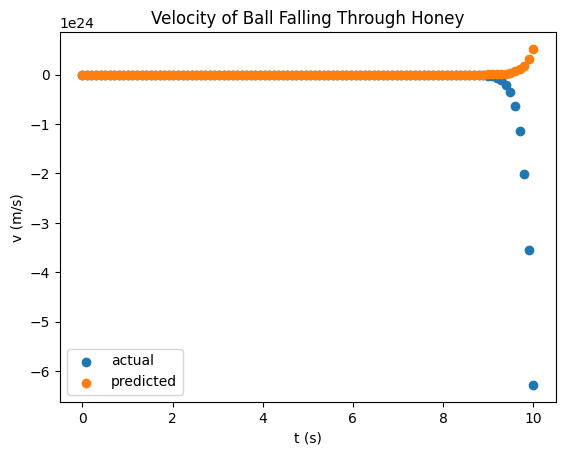Physics-Informed Fitness#
Goal: Show how fitness functions can be customized to enforce problem-specific constraints.#
Pre-Requisites#
It is recommended to check out the symbolic regression tutorial before continuing.
Problem Description#
A basic physics problem that benefits from using physics-informed fitness is modeling the velocity of an object falling through a viscous liquid. Here we’ll model a the velocity of a ball falling through honey. Using Newton’s 2nd law (\(F = ma \to a = F/m\)), we can derive that \(a = g - cv/m\) where \(g\) is the acceleration due to gravity, \(c\) is a drag term, \(v\) is the velocity of the ball, and \(m\) is the mass of the ball. We can use this fact to enforce that the models Bingo produces for velocity are physically consistent.
TODO free-body diagram showing problem, note that we are not factoring buoyancy here
Creating Training Data#
We can integrate \(a = g - cv/m\) to get the true equation of the ball’s velocity as it falls through a fluid: \(\frac{mg}{c} \left(1 - \exp \left(\frac{ct}{m}\right)\right)\). Note that while we can derive the true equation in this case, there are problems where we can’t do so and only have training data. So, we will only be using this true equation to generate training data and use GPSR to get a model from the data.
Let’s assume our ball has a mass of 1 \(kg\) and a radius of 3 \(cm\); on Earth \(g\) is roughly 9.8 \(m/s^2\); and for the ball dropping through honey, \(c\) is roughly \(1.8 \pi \, kg/s \approx 5.655 \, kg/s\) (Stokes’ Law without velocity) at \(\text{20}^{\circ}\)C.
[1]:
import numpy as np
m = 1
r = 3.0/100.0
g = 9.8
c = 5.655
t = np.linspace(0, 10, num=100).reshape((-1, 1))
v = m * g / c * (1 - np.exp(c * t / m))
[2]:
import matplotlib.pyplot as plt
plt.scatter(t, v)
plt.xlabel("t (s)")
plt.ylabel("v (m/s)")
plt.title("Velocity of Ball Falling Through Honey")
plt.show()

Symbolic Regression Setup#
See the symbolic regression tutorial for more information.
AGraph Component Generator#
[3]:
from bingo.symbolic_regression import ComponentGenerator
component_generator = ComponentGenerator(input_x_dimension=t.shape[1])
component_generator.add_operator("-")
component_generator.add_operator("*")
component_generator.add_operator("/")
component_generator.add_operator("exp")
/home/runner/work/bingo/bingo/bingo/symbolic_regression/__init__.py:31: UserWarning: Could not load C++ modules No module named 'bingocpp.build'
warnings.warn(f"Could not load C++ modules {import_err}")
AGraph Generator#
[4]:
from bingo.symbolic_regression import AGraphGenerator
AGRAPH_SIZE = 10
agraph_generator = AGraphGenerator(agraph_size=AGRAPH_SIZE,
component_generator=component_generator)
AGraph Variation#
[5]:
from bingo.symbolic_regression import AGraphCrossover, AGraphMutation
crossover = AGraphCrossover()
mutation = AGraphMutation(component_generator)
Evaluation#
Defining the Custom Fitness Function#
Here we’re going to create our own fitness function based on the existing ExplicitRegression which is used for typical symbolic regression.
[6]:
from bingo.symbolic_regression import ExplicitRegression
class FallingBallRegression(ExplicitRegression):
def __init__(self, training_data, mass_of_ball, radius_of_ball,
g, drag_term, metric="mae", relative=False):
super().__init__(training_data, metric, relative)
self.m = mass_of_ball
self.r = radius_of_ball
self.g = g
self.c = drag_term
def evaluate_fitness_vector(self, individual):
typical_fitness_vector = super().evaluate_fitness_vector(individual)
v, dv_dt = individual.evaluate_equation_with_x_gradient_at(
self.training_data.x)
v, dv_dt = np.nan_to_num(v.flatten()), np.nan_to_num(dv_dt.flatten())
derivative_fitness_vector = self.g - self.c * v / self.m - dv_dt
return typical_fitness_vector + derivative_fitness_vector
In __init__, we are defining the same arguments that ExplicitRegression needs (training_data, metric, and relative) as well as information specific to our problem (mass_of_ball, radius_of_ball, g, and drag_term). Then we are setting up ExplicitRegression and storing the physics terms in our object.
In evaluate_fitness_vector, we are getting the normal fitness vector using ExplicitRegression’s evaluate_fitness_vector and adding it with a physics-informed derivative_fitness_vector. The derivative_fitness_vector penalizes the individual if its velocity predictions do not abide by the known \(a = \frac{dv}{dt} = g - \frac{cv}{m}\). We can do this by using AGraph’s evaluate_equation_with_x_gradient_at which will normally give us \(y\), \(dy/dx\), but in
our case \(x=t\) and \(y=v\), so we get \(v\), \(dv/dt\).
Using the Custom Fitness Function in Evaluation#
Let’s instantiate and wrap our custom fitness function with ContinuousLocalOptimization to allow for local optimization of AGraph constants.
[7]:
from bingo.symbolic_regression import ExplicitTrainingData
from bingo.local_optimizers.scipy_optimizer import ScipyOptimizer
from bingo.local_optimizers.local_opt_fitness import LocalOptFitnessFunction
training_data = ExplicitTrainingData(t, v)
fitness = FallingBallRegression(training_data=training_data, mass_of_ball=m,
radius_of_ball=r, g=g, drag_term=c)
optimizer = ScipyOptimizer(fitness, method='lm')
local_opt_fitness = LocalOptFitnessFunction(fitness, optimizer)
We can then use the fitness function in Evaluation.
[8]:
from bingo.evaluation.evaluation import Evaluation
evaluator = Evaluation(local_opt_fitness)
Evolutionary Algorithm#
[9]:
from bingo.evolutionary_algorithms.age_fitness import AgeFitnessEA
POPULATION_SIZE = 50
MUTATION_PROB = 0.1
CROSSOVER_PROB = 0.4
ea = AgeFitnessEA(evaluator, agraph_generator, crossover, mutation,
CROSSOVER_PROB, MUTATION_PROB, POPULATION_SIZE)
Pareto Front#
[10]:
from bingo.stats.pareto_front import ParetoFront
def agraph_similarity(ag_1, ag_2):
"""a similarity metric between agraphs"""
return ag_1.fitness == ag_2.fitness and ag_1.get_complexity() == ag_2.get_complexity()
pareto_front = ParetoFront(secondary_key=lambda ag: ag.get_complexity(),
similarity_function=agraph_similarity)
Evolutionary Optimizer#
[11]:
from bingo.evolutionary_optimizers.island import Island
island = Island(ea, agraph_generator, POPULATION_SIZE, hall_of_fame=pareto_front)
Running Symbolic Regression#
Now we can run symbolic regression on our training data to produce a model.
[12]:
import random
MAX_GENS = 1000
ERR_THRESHOLD = 0.001
np.random.seed(0)
random.seed(0)
island.evolve_until_convergence(MAX_GENS, ERR_THRESHOLD)
/home/runner/work/bingo/bingo/bingo/symbolic_regression/agraph/evaluation_backend/operator_eval.py:173: RuntimeWarning: overflow encountered in exp
return np.exp(forward_eval[param1])
/tmp/ipykernel_9823/3026084833.py:19: RuntimeWarning: overflow encountered in multiply
derivative_fitness_vector = self.g - self.c * v / self.m - dv_dt
/home/runner/work/bingo/bingo/bingo/symbolic_regression/agraph/evaluation_backend/operator_eval.py:93: RuntimeWarning: overflow encountered in scalar multiply
return forward_eval[param1] * forward_eval[param2]
/home/runner/work/bingo/bingo/bingo/symbolic_regression/agraph/evaluation_backend/operator_eval.py:98: RuntimeWarning: overflow encountered in scalar multiply
reverse_eval[param2] += reverse_eval[reverse_index] * forward_eval[param1]
/home/runner/work/bingo/bingo/bingo/symbolic_regression/agraph/evaluation_backend/operator_eval.py:177: RuntimeWarning: overflow encountered in scalar multiply
reverse_eval[param1] += reverse_eval[reverse_index] * forward_eval[reverse_index]
/home/runner/work/bingo/bingo/bingo/symbolic_regression/agraph/evaluation_backend/operator_eval.py:97: RuntimeWarning: overflow encountered in scalar multiply
reverse_eval[param1] += reverse_eval[reverse_index] * forward_eval[param2]
/home/runner/work/bingo/bingo/bingo/symbolic_regression/agraph/evaluation_backend/operator_eval.py:93: RuntimeWarning: overflow encountered in multiply
return forward_eval[param1] * forward_eval[param2]
/home/runner/work/bingo/bingo/bingo/symbolic_regression/agraph/evaluation_backend/operator_eval.py:97: RuntimeWarning: overflow encountered in multiply
reverse_eval[param1] += reverse_eval[reverse_index] * forward_eval[param2]
/home/runner/work/bingo/bingo/bingo/symbolic_regression/agraph/evaluation_backend/operator_eval.py:98: RuntimeWarning: overflow encountered in multiply
reverse_eval[param2] += reverse_eval[reverse_index] * forward_eval[param1]
/home/runner/work/bingo/bingo/bingo/symbolic_regression/agraph/evaluation_backend/operator_eval.py:177: RuntimeWarning: overflow encountered in multiply
reverse_eval[param1] += reverse_eval[reverse_index] * forward_eval[reverse_index]
/opt/hostedtoolcache/Python/3.14.0/x64/lib/python3.14/site-packages/scipy/optimize/_minpack_py.py:498: RuntimeWarning: overflow encountered in matmul
cov_x = invR @ invR.T
/home/runner/work/bingo/bingo/bingo/symbolic_regression/agraph/evaluation_backend/operator_eval.py:109: RuntimeWarning: overflow encountered in scalar divide
reverse_eval[reverse_index] * forward_eval[reverse_index] / forward_eval[param2]
/tmp/ipykernel_9823/3026084833.py:19: RuntimeWarning: overflow encountered in subtract
derivative_fitness_vector = self.g - self.c * v / self.m - dv_dt
/home/runner/work/bingo/bingo/bingo/symbolic_regression/agraph/evaluation_backend/operator_eval.py:107: RuntimeWarning: overflow encountered in divide
reverse_eval[param1] += reverse_eval[reverse_index] / forward_eval[param2]
/home/runner/work/bingo/bingo/bingo/symbolic_regression/agraph/evaluation_backend/operator_eval.py:109: RuntimeWarning: overflow encountered in multiply
reverse_eval[reverse_index] * forward_eval[reverse_index] / forward_eval[param2]
/home/runner/work/bingo/bingo/bingo/symbolic_regression/agraph/evaluation_backend/operator_eval.py:109: RuntimeWarning: overflow encountered in divide
reverse_eval[reverse_index] * forward_eval[reverse_index] / forward_eval[param2]
/home/runner/work/bingo/bingo/bingo/symbolic_regression/agraph/evaluation_backend/operator_eval.py:98: RuntimeWarning: overflow encountered in add
reverse_eval[param2] += reverse_eval[reverse_index] * forward_eval[param1]
/home/runner/work/bingo/bingo/bingo/symbolic_regression/agraph/evaluation_backend/operator_eval.py:103: RuntimeWarning: overflow encountered in divide
return forward_eval[param1] / forward_eval[param2]
/home/runner/work/bingo/bingo/bingo/symbolic_regression/agraph/evaluation_backend/operator_eval.py:177: RuntimeWarning: overflow encountered in add
reverse_eval[param1] += reverse_eval[reverse_index] * forward_eval[reverse_index]
[12]:
OptimizeResult(success=False, status=2, message='The maximum number of generational steps (1000) occurred', ngen=1000, fitness=np.float64(2.0788662477029563e+22), time=12.277818, ea_diagnostics=EaDiagnosticsSummary(beneficial_crossover_rate=np.float64(0.010220518802421818), detrimental_crossover_rate=np.float64(0.39015719602288507), beneficial_mutation_rate=np.float64(0.05149781218444968), detrimental_mutation_rate=np.float64(0.5442611915180074), beneficial_crossover_mutation_rate=np.float64(0.013190034196384953), detrimental_crossover_mutation_rate=np.float64(0.4587200781631656)))
Results#
[13]:
best_individual = pareto_front[0]
pred_v = best_individual.evaluate_equation_at(t)
plt.scatter(t, v)
plt.scatter(t, pred_v)
plt.xlabel("t (s)")
plt.ylabel("v (m/s)")
plt.legend(["actual", "predicted"])
plt.title("Velocity of Ball Falling Through Honey")
plt.show()

